SALVATORE ZOFREA | PAINTINGS AND WOODCUT PRINTS
18 OCTOBER - 12 NOVEMBER 2017
The Nancy Sever Gallery was pleased to present an exhibition of work by Salvatore Zofrea, one of Australia’s leading artists.
Salvatore Zofrea was born in Italy in 1946 and relocated to Australia at the age of six. He studied at the Julian Ashton Art School and held his first exhibition at the Macquarie Galleries in 1967, going on to win the Sulman Prize in 1977 and again in 1979 and 1982. In 1982 he was awarded a six-month residency at the Cité international des Arts in Paris and in 1985 he was the recipient of a Churchill Fellowship to study fresco painting in Italy. His work is to be found in the National Gallery of Australia, the National Portrait Gallery, the Museum of Modern Art in New York, the Vatican Collection, the Art Gallery of New South Wales and other leading national and international collections.
A constant reference point in the artist’s work is nature’s bounty, first impressed on him during his early childhood in rural Italy and now surrounding him in the Australian bush. Years of observation have given him a deep understanding and appreciation of the bushland of Kurrajong in the Blue Mountains, where he lives and works, and to which he has developed a deep spiritual attachment.
He is a sumptuous colourist who has documented the Australian flora and the landscapes in which it is set with remarkable focus and attention to detail. His lyrical and exuberant compositions testify to the amazing diversity of native plants in the Australian bush. The best known species are represented in his work: golden wattle, bottlebrush, grevillea, red wax, irises, native fuschias and Christmas bells- all of which, incidentally, can be found in parks, gardens and reserves in and around Canberra.
The exhibition opened at the Nancy Sever Gallery on Wednesday 18 October 2017 and run to 12 November. For further information please contact Nancy Sever at nancy.sever@iinet.com.au or Tel 02 6239 5434. The Gallery is open Wednesday – Sunday 11 am – 6 pm.
Artworks included in the exhibition:
(for details of the works, please click and hold cursor over the image)
Views of the exhibition:
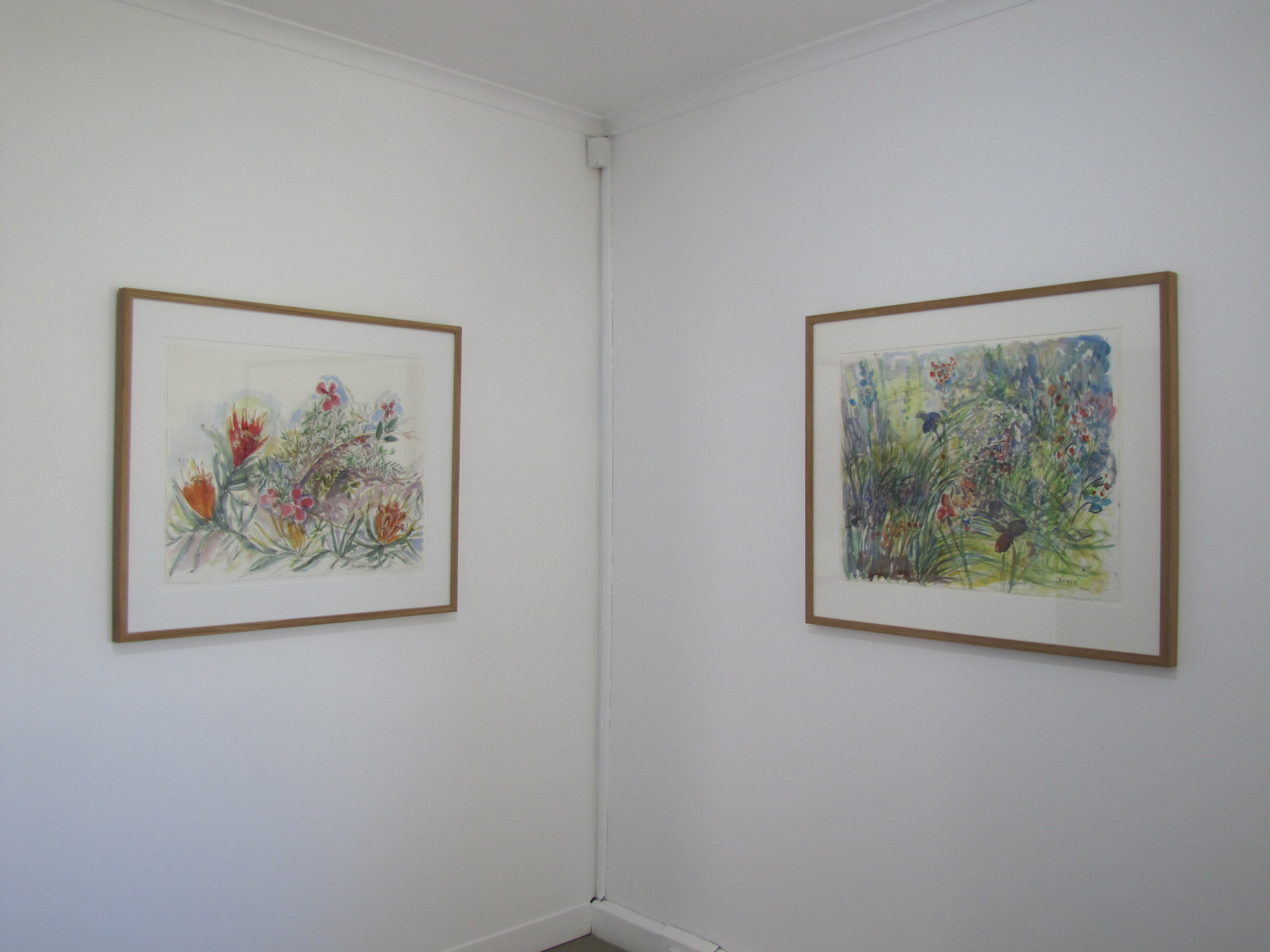
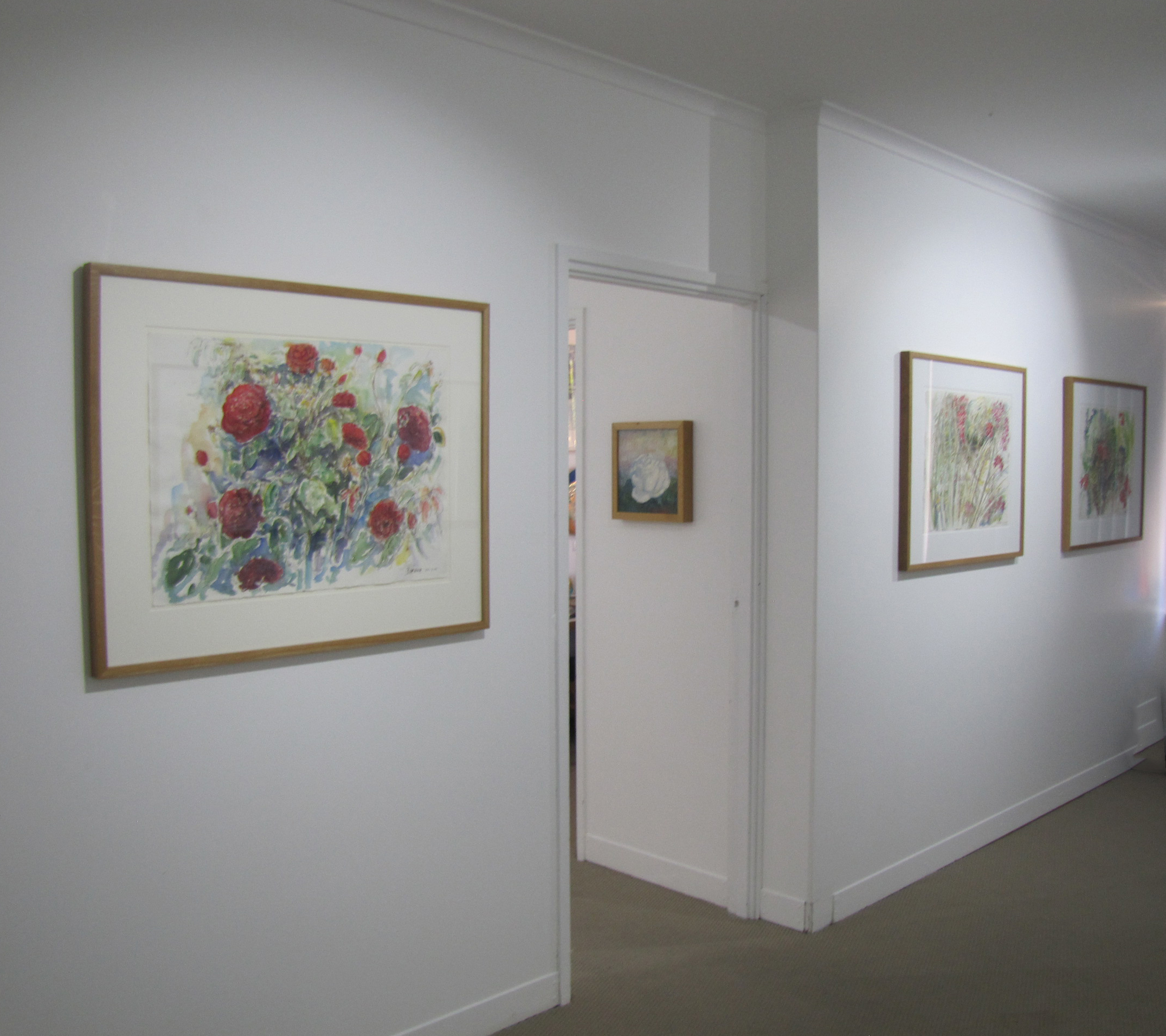
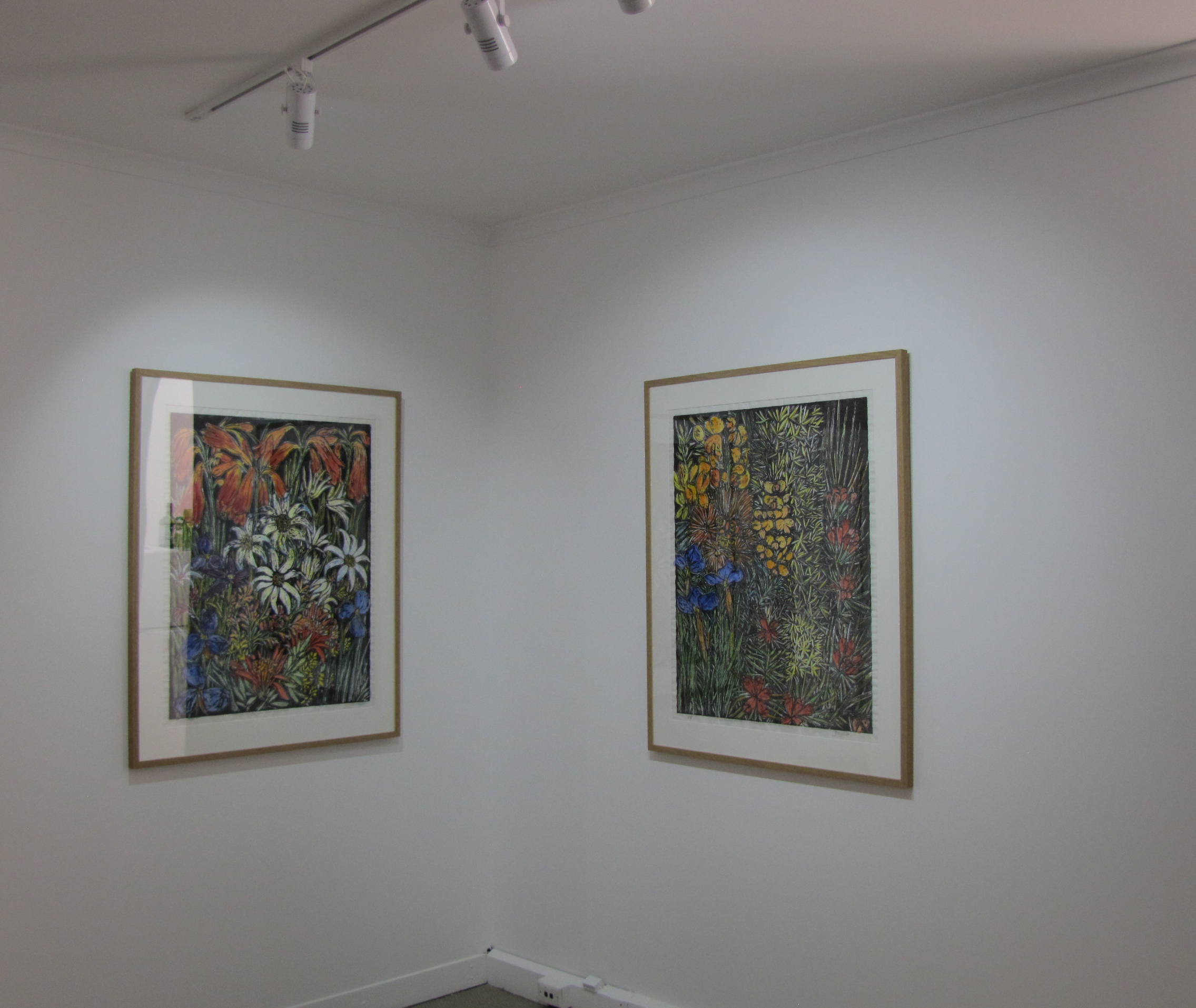
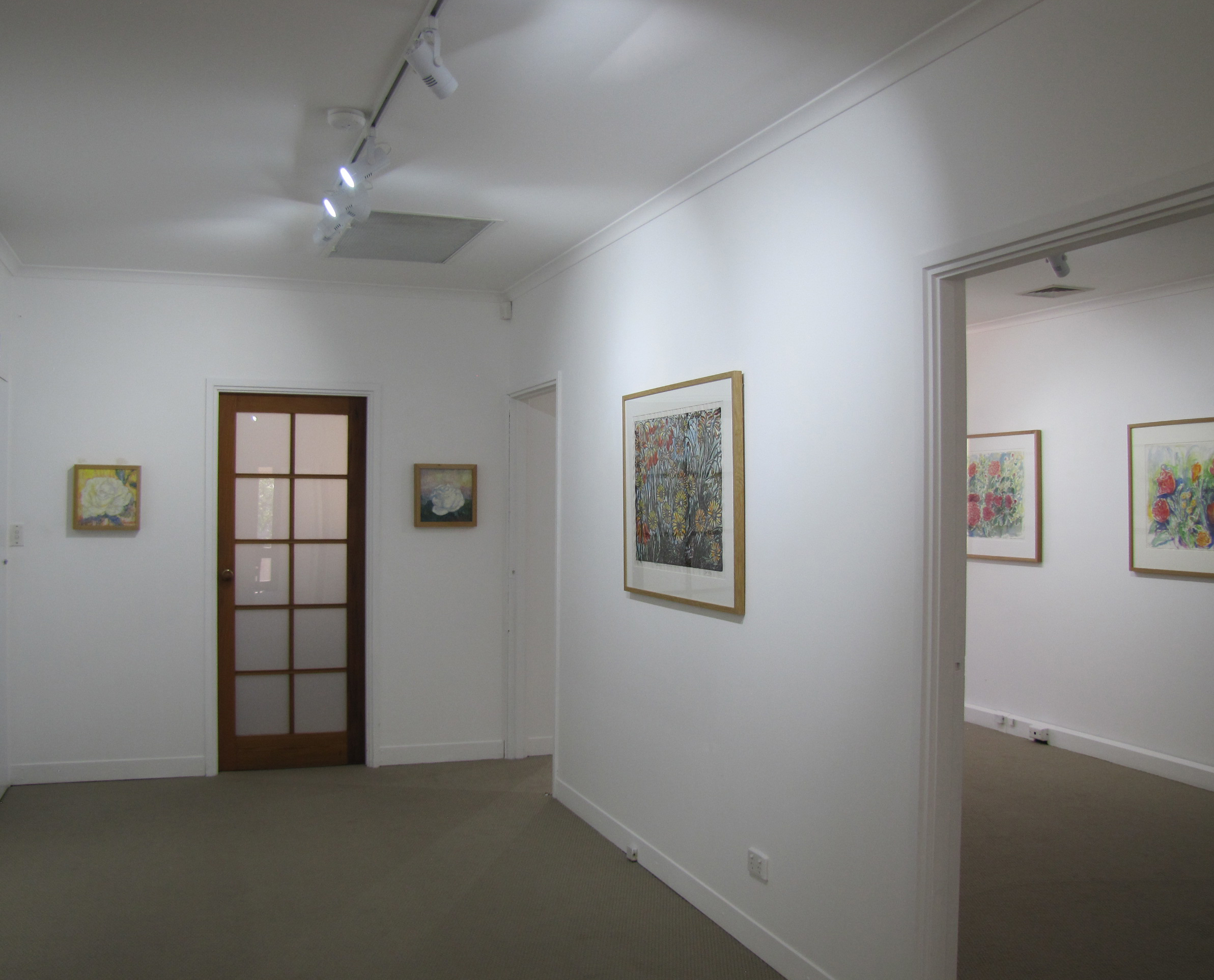
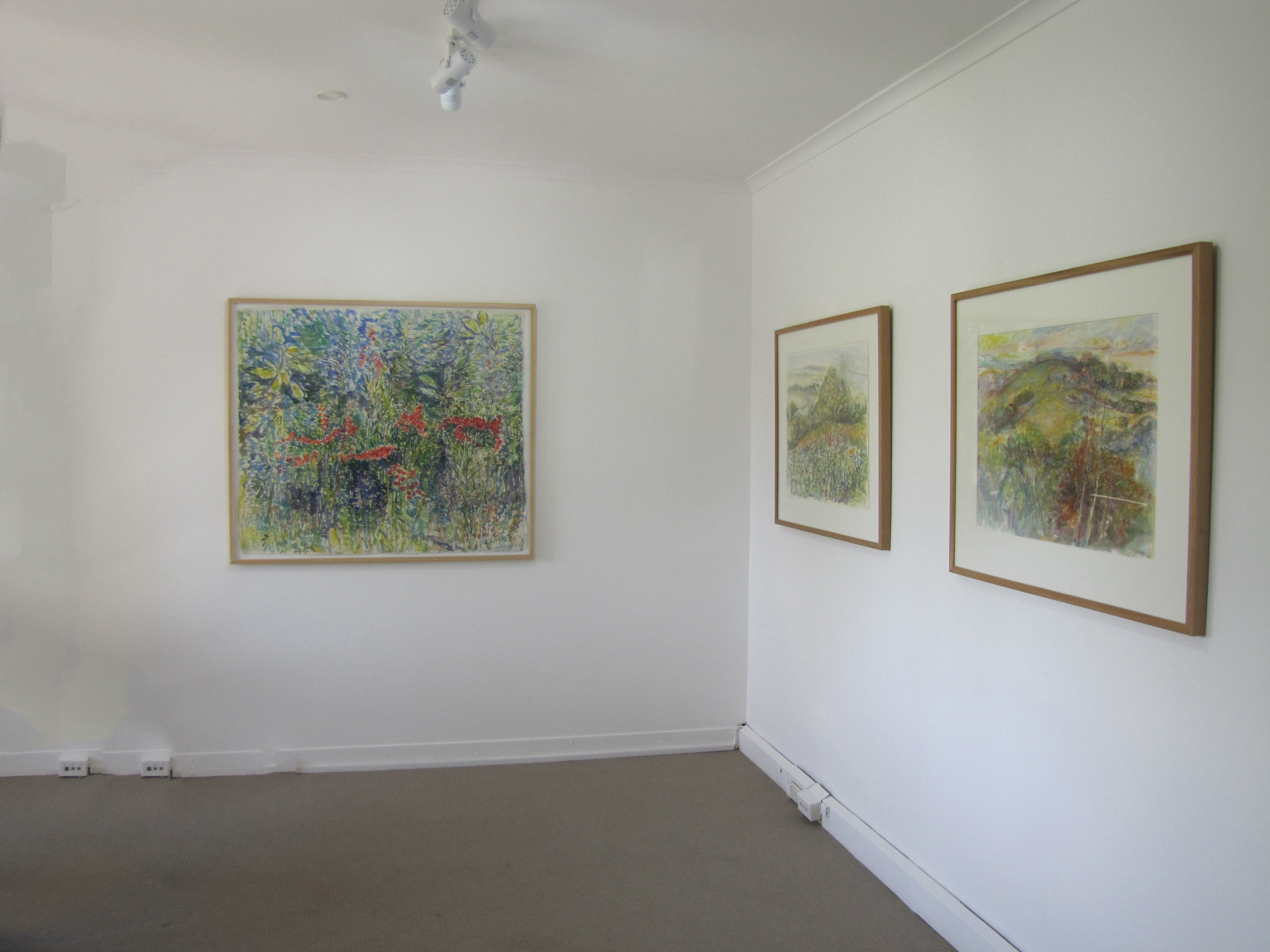
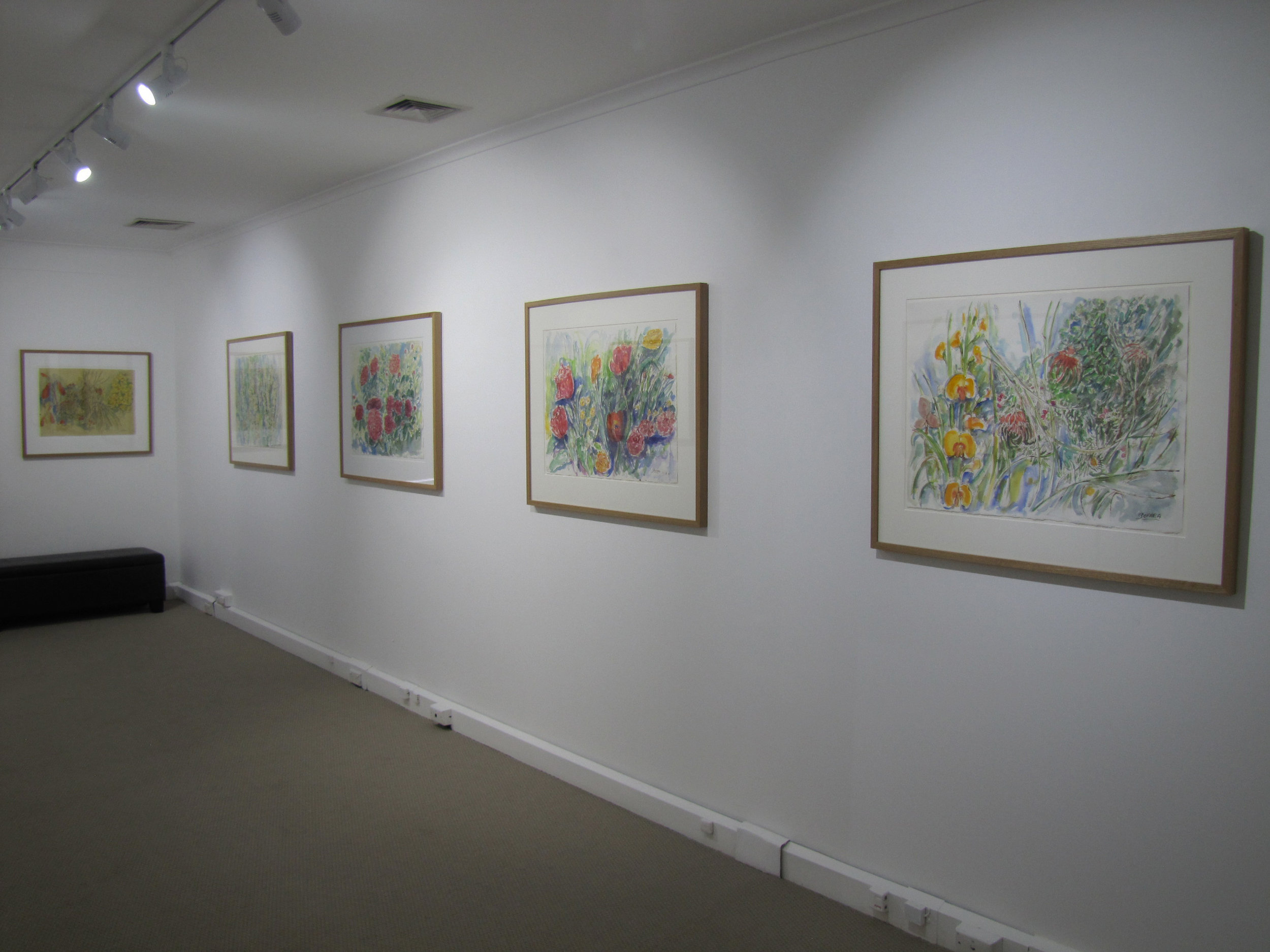
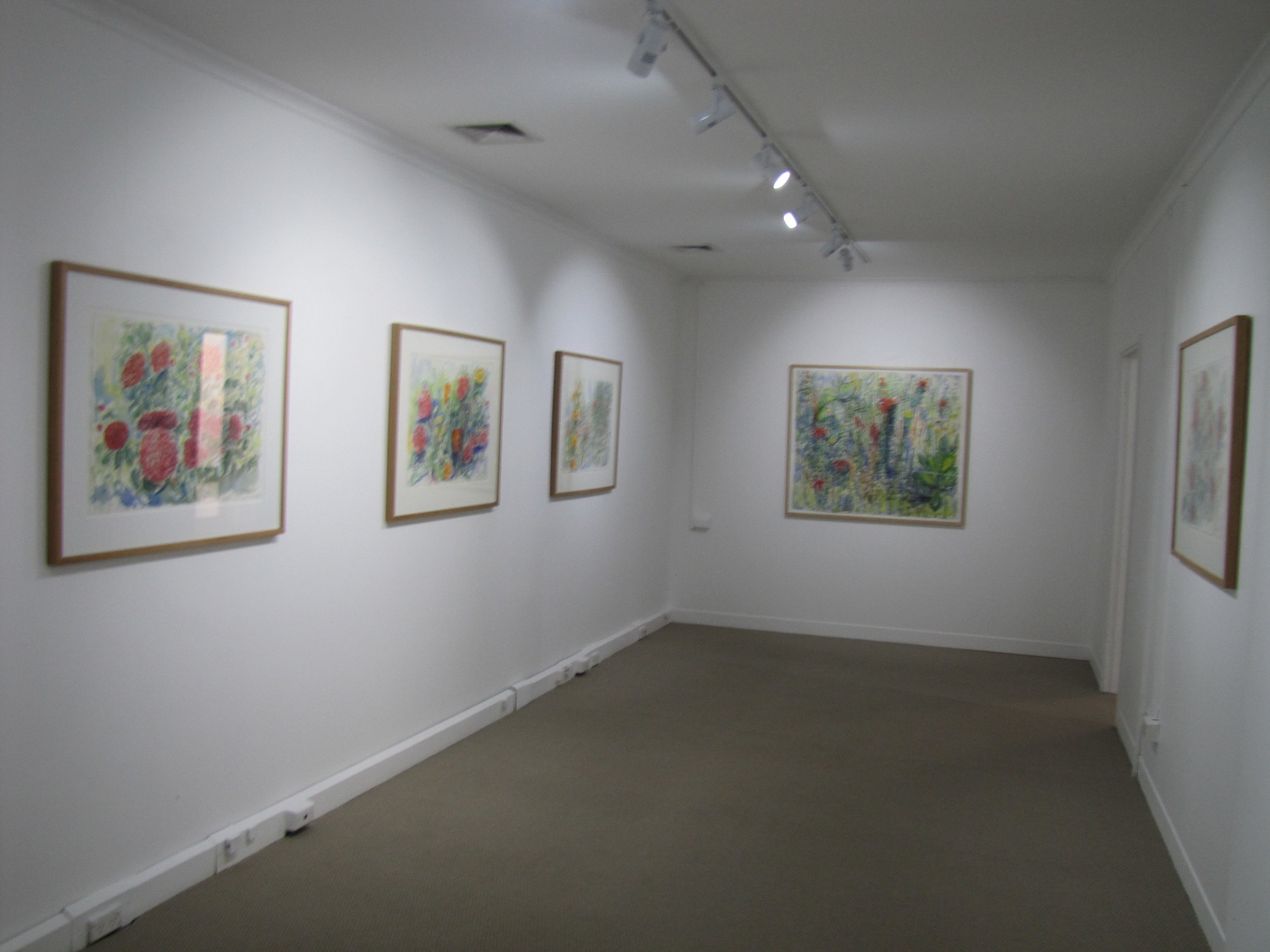

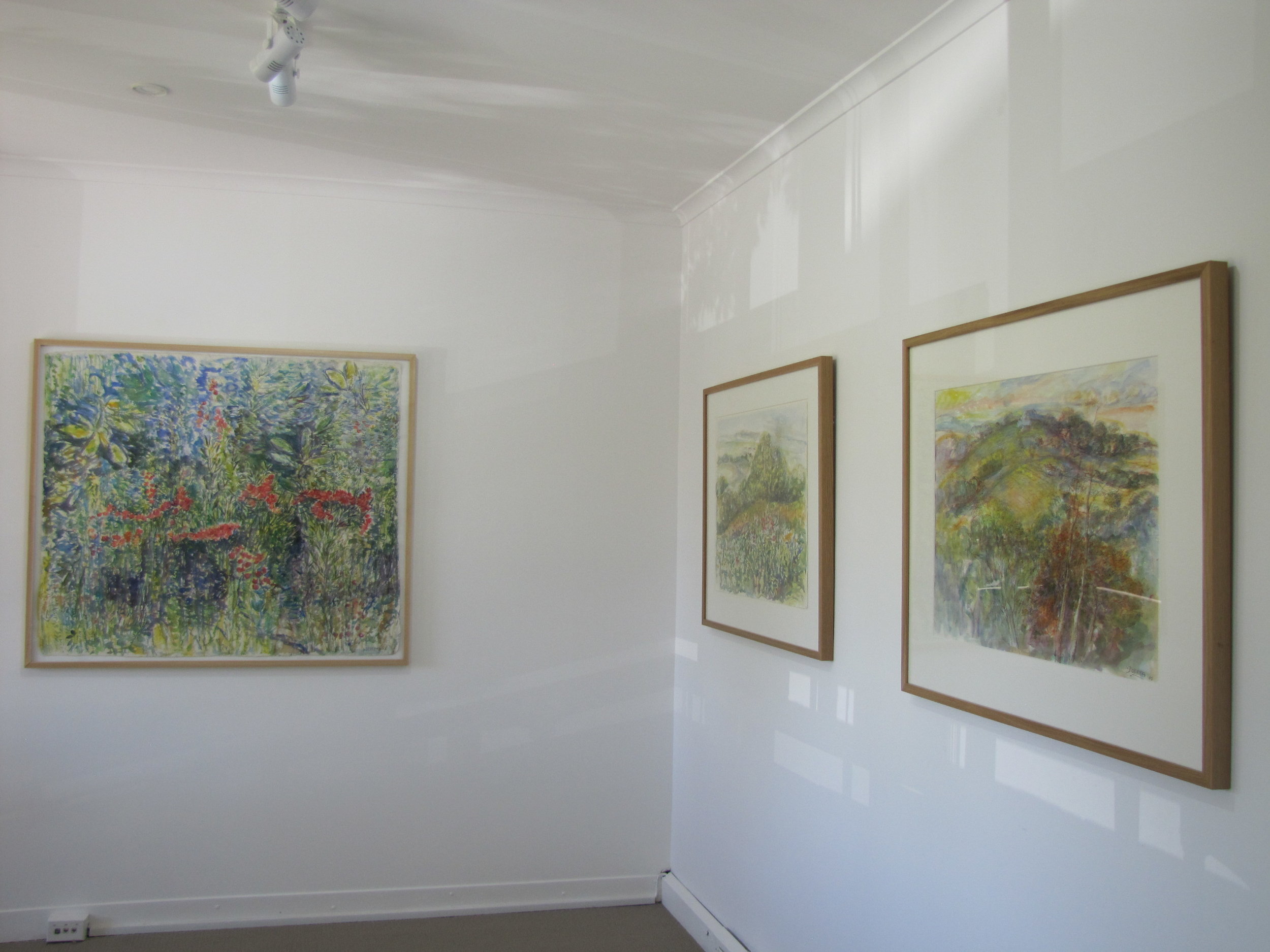
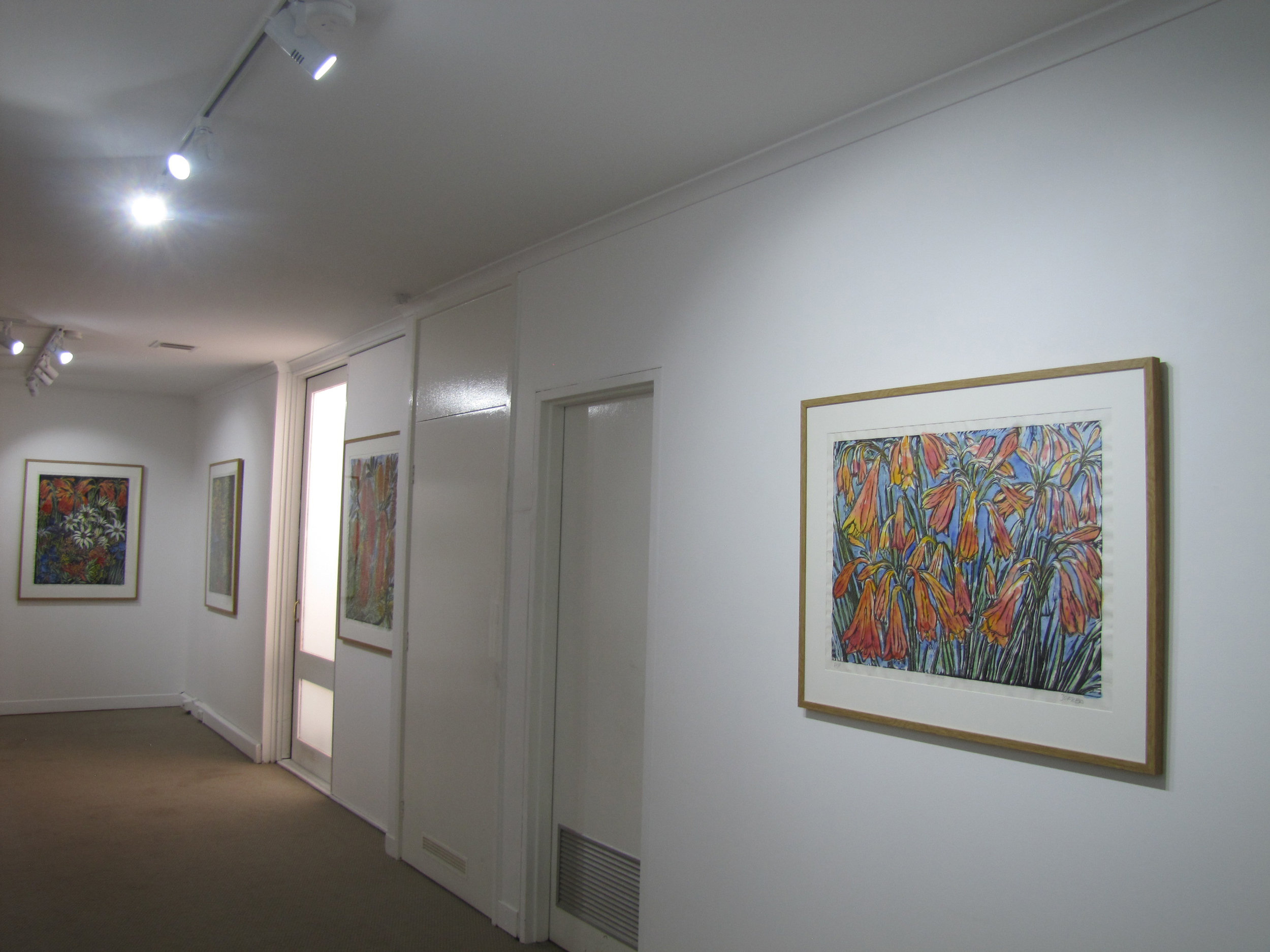
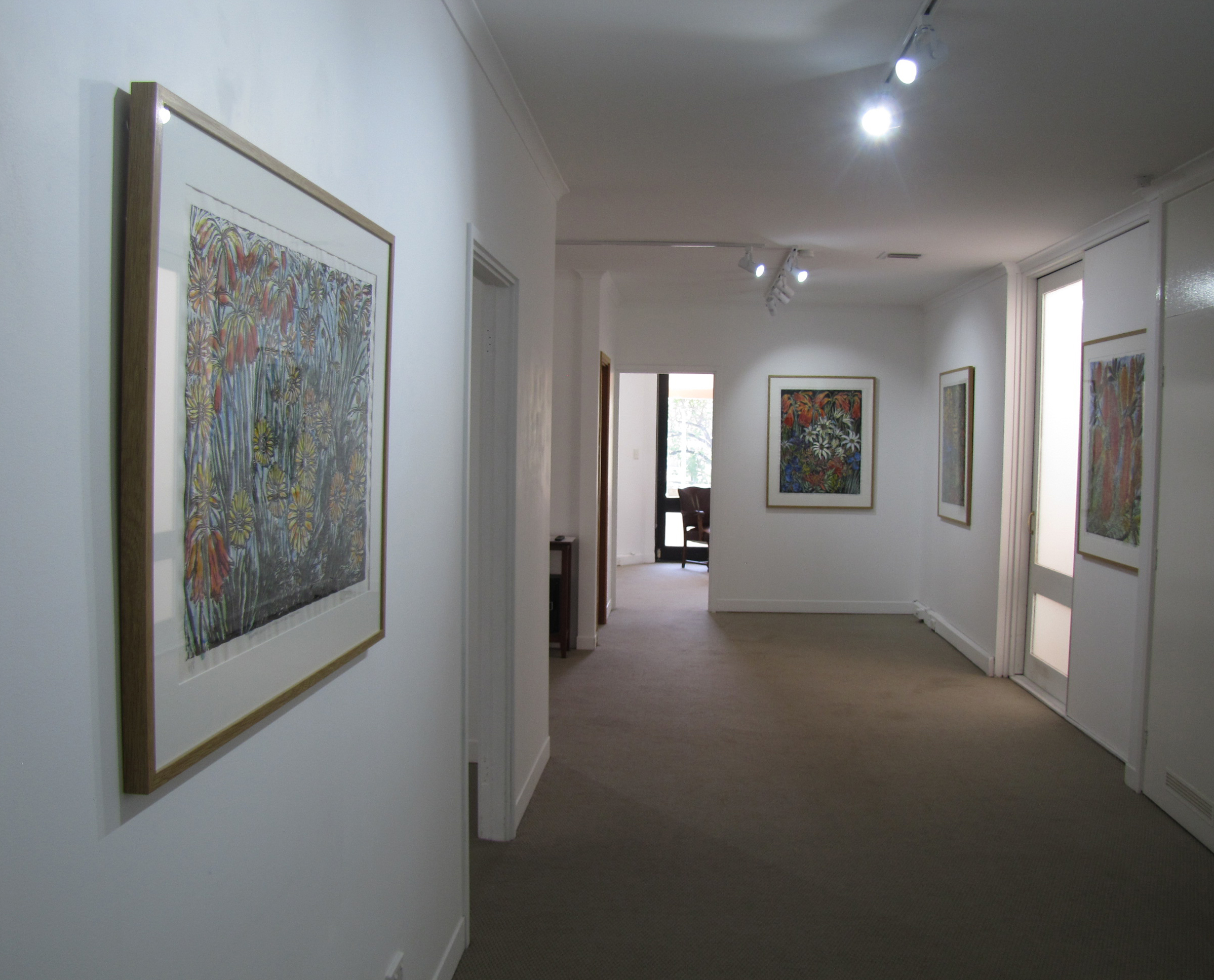
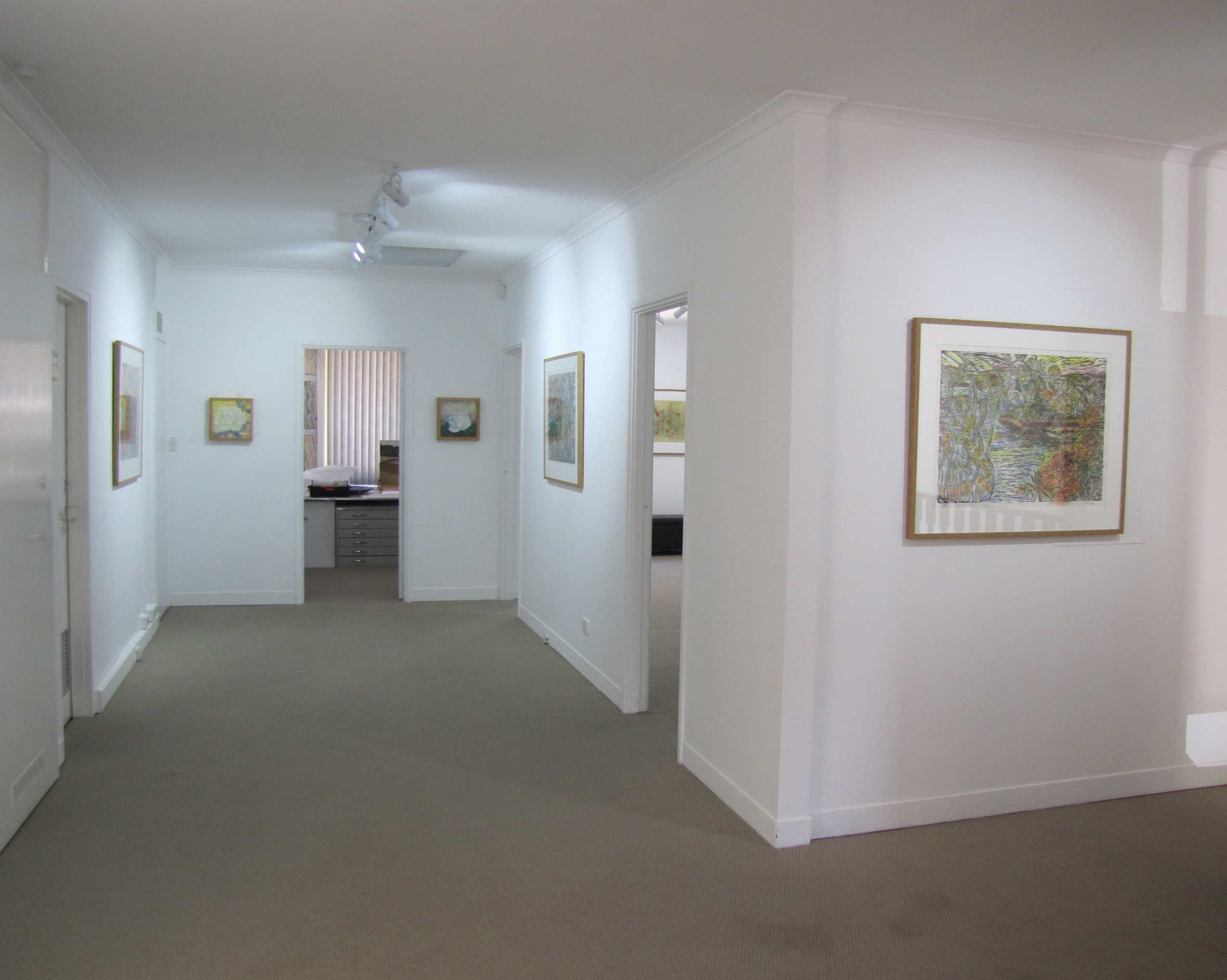
Salvatore Zofrea Biographical details
Solo exhibitions
2017 ‘Paintings and Woodcut Prints, Nancy Sever Gallery, Canberra
‘Wildflowers’, Manly Art Gallery & Museum, Sydney
2016 ‘Watercolours and oils’, Australian Galleries, Sydney
2014 ‘Morning Light’, Australian Galleries, Roylston Street, Sydney
2011 ‘Forest Flowers’, Australian Galleries, Roylston Street, Sydney
2009 ‘Days of Summer’, Drill Hall Gallery, Australian National University, Canberra
2008 ‘Salvatore Zofrea’, Australian Galleries, Roylston Street, Sydney
‘Days of Summer’, Mosman Art Gallery, Sydney
1998 Manly Art Gallery & Museum, Sydney
‘Works on paper’, Von Bertouch Gallery, Newcastle, NSW
1996 David Jones Art Gallery, Sydney
1995 ‘Woodcuts from the Canecutters and Odyssey series’, Art Gallery of New South Wales, Sydney
1994 ‘Salvatore Zofrea, an Italo-Australian Odyssey‘, Rome, Italy
1993 ‘Drawings for the Sydney Opera House fresco’, Macquarie Galleries, Sydney
1992 Macquarie Galleries, Sydney
Von Bertouch Gallery, Newcastle, NSW
‘Capricornia Suite’, Brisbane City Art Gallery and Museum, Brisbane
‘The Psalms’, Touring: Art Gallery of New South Wales, Sydney; New
England Regional Art Museum, NSW; Newcastle Region Art Gallery, NSW;
Broken Hill Regional Art Gallery, NSW; Wagga Wagga Art Gallery, NSW;
Goulburn Regional Art Gallery, NSW; Orange Regional Gallery, NSW
‘Capricornia Suite’, Karnak Playhouse, Port Douglas, QLD
Primavera Gallery, Canberra
1991 ‘Capricornia Suite woodcuts’, Macquarie Galleries, Sydney
1990 ‘An Odyssey’, Macquarie Galleries, Sydney and Wollongong City Gallery, Wollongong, NSW
1989 ‘Studies for Psalm 37, Homage to Uccello II, 1989’, Macquarie Galleries, Sydney
Vincent Art Gallery, Adelaide
1987 ‘Psalm paintings’, Macquarie Galleries, Sydney
1986 ‘Tasmania’, Macquarie Galleries, Sydney
1985 ‘The creation’, Macquarie Galleries, Sydney
1984 ‘Days of Heaven’, Macquarie Galleries, Sydney
1983 ‘Saint Francis and Saint Clare’, Macquarie Galleries, Sydney
1982 ‘The Psalm paintings’, Macquarie Galleries, Sydney
‘1982 festival exhibition’, The Fine Arts Gallery, Perth
1981 ‘Viewing of studies for the Herald mural plus commissioned portraits’,
Macquarie Galleries, Sydney
‘Lord Howe Island 1981: paintings and drawings of Lord Howe Island’,
Macquarie Galleries, Sydney
‘Lord Howe Island 1981: exhibition of paintings’, NSW Government
Information Centre, Sydney
1980 David Jones Gallery, Sydney
1979 Victor Mace Fine Art Gallery, Brisbane
Von Bertouch Gallery, Newcastle, NSW
1978 Victor Mace Fine Art Gallery, Brisbane
Von Toussaint Gallery, Perth
1977 Macquarie Galleries, Sydney and Canberra
1976 Macquarie Galleries, Sydney and Canberra
1975 Macquarie Galleries, Sydney
Victor Mace Fine Art Gallery, Brisbane
1973 Macquarie Galleries, Canberra
1972 Toorak Galleries, Melbourne
1971 Macquarie Galleries, Canberra
1970 Toorak Galleries, Melbourne
1969 Bonython Galleries, Sydney and Adelaide
1968 Bonython Galleries, Adelaide
1967 Macquarie Galleries, Sydney
Selected group exhibitions.
2017 Wynne Prize, Art Gallery of New South Wales, Sydney
‘Artist Profile: Australasian Painters 2007-2017’, Orange Regional Gallery, Orange NSW
2016 Tattersall’s Club Landscape Art Prize, touring Redland Art Gallery, Cleveland, QLD, Gympie Regional Gallery, Gympie, QLD,
Gladstone Regional Art Gallery and Museum, Gladstone Central, QLD, Childers Art Space, Childers, QLD,
Toowoomba Regional Art Gallery, Toowoomba, QLD and Roma on Bungil Gallery, Roma, QLD
‘Salon des Refusés’, S.H Ervin Gallery, Sydney
2015 ‘An exhibition of paintings, sculpture & works on paper’, Australian Galleries, Roylston Street, Sydney
‘Just Paper – The piano has been drinking (not me),’ Maitland Regional Art Gallery, Maitland, NSW
‘Garden’, QUT Art Museum, Queensland University of Technology, Brisbane
2014 Archibald Prize, Art Gallery of New South Wales, Sydney
Wynne Prize, Art Gallery of New South Wales, Sydney
‘one of each’, Australian Galleries, Derby Street, Melbourne
2013 Wynne Prize, Art Gallery of New South Wales, Sydney
2011 ‘large exhibition of small works’, Australian Galleries, Roylston Street, Sydney
‘large exhibition of small works’, Australian Galleries, Derby Street, Melbourne
Wynne Prize, Art Gallery of New South Wales, Sydney
2010 ‘Summer Show’, Australian Galleries, Glenmore Road, Sydney
‘Artists’ Prints made with Integrity I’, Australian Galleries, Smith Street, Melbourne
2008 ‘Stock Show’, Australian Galleries, Glenmore Road, Sydney
2002 ’50 Portraits’, S.H. Ervin Gallery, Sydney
1999 Archibald Prize, Art Gallery of New South Wales, Sydney
Sulman Prize, Art Gallery of New South Wales, Sydney
Dobell Prize, Art Gallery of New South Wales, Sydney
‘Landscapes in sets and series, Australian prints 1960s – 1990s’, National Gallery of Australia, Canberra
1998 Archibald Prize, Art Gallery of New South Wales, Sydney
Sulman Prize, Art Gallery of New South Wales, Sydney
Dobell Drawing Prize, Art Gallery of New South Wales, Sydney
1997 Archibald Prize, Art Gallery of New South Wales, Sydney
Sulman Prize, Art Gallery of New South Wales, Sydney
Dobell Prize, Art Gallery of New South Wales, Sydney
‘Collectors choice’, Von Bertouch Galleries, Newcastle, NSW
1996 Archibald Prize, Art Gallery of New South Wales, Sydney
Dobell Drawing Prize, Art Gallery of New South Wales, Sydney
1995 Archibald Prize, Art Gallery of New South Wales, Sydney
Sulman Prize, Art Gallery of New South Wales, Sydney
1990 Archibald Prize, Art Gallery of New South Wales, Sydney
1989 Sulman Prize, Art Gallery of New South Wales, Sydney
1988 Sulman Prize, Art Gallery of New South Wales, Sydney
1987 Wynne Prize, Art Gallery of New South Wales, Sydney
1986 Archibald Prize, Art Gallery of New South Wales, Sydney
Sulman Prize, Art Gallery of New South Wales, Sydney
Wynne Prize, Art Gallery of New South Wales, Sydney
1984 Archibald Prize, Art Gallery of New South Wales, Sydney
Sulman Prize, Art Gallery of New South Wales, Sydney
1983 Archibald Prize, Art Gallery of New South Wales, Sydney
Sulman Prize, Art Gallery of New South Wales, Sydney
1982 Archibald Prize, Art Gallery of New South Wales, Sydney
Sulman Prize (Winner), Art Gallery of New South Wales, Sydney
Wynne Prize, Art Gallery of New South Wales, Sydney
1981 Archibald Prize, Art Gallery of New South Wales, Sydney
Sulman Prize, Art Gallery of New South Wales, Sydney
1980 Archibald Prize, Art Gallery of New South Wales, Sydney
1979 Archibald Prize, Art Gallery of New South Wales, Sydney
Sulman Prize (Winner), Art Gallery of New South Wales, Sydney
1978 ‘Recent major works by figurative painters’, Macquarie Galleries, Sydney
‘Collectors choice’, Von Bertouch Galleries, Newcastle, NSW
Archibald Prize, Art Gallery of New South Wales, Sydney
Sulman Prize, Art Gallery of New South Wales, Sydney
Wynne Prize, Art Gallery of New South Wales, Sydney
1977 Blake Prize, Commonwealth Savings Bank, Sydney
Sulman Prize (Winner), Art Gallery of New South Wales, Sydney
1975 ‘Fifty years of the Macquarie Galleries’, Macquarie Galleries, Sydney
Blake Prize, Commonwealth Savings Bank, Sydney
1970 ‘Collectors choice’, Von Bertouch Galleries, Newcastle, NSW
1969 ‘Figurative Paintings’, Macquarie Galleries, Sydney
1968 Blake Prize, Commonwealth Savings Bank, Sydney
1967 Blake Prize, Commonwealth Savings Bank, Sydney
Awards
1995 Italo-Australian Man of the Year Achievement, awarded by Italian National Day Celebration Committee, Sydney
Awarded title of Cavaliere (Knighthood) by the Italian Government in recognition of his contribution to art in Australia, Italy
1992 Sydney Opera House Fresco sponsored by Toshiba Pty Ltd, Sydney
1986 Churchill Fellowship to study fresco painting in Italy, Canberra
1982 Winner, Sulman Prize, Art Gallery of New South Wales, Sydney
Power Bequest Studio Residency, Cité Internationale des Arts, Paris, France
1979 Winner, Sulman Prize, Art Gallery of New South Wales, Sydney
1977 Winner, Sulman Prize, Art Gallery of New South Wales, Sydney
Commissions
2005 MBF Health Insurance, Sydney
2000 ‘Te Deum’, ResMed Ltd, Sydney
1998 ‘Celebration of Life – A Picnic at Clontarf’, NRMA, Sydney
1997 ‘Spring Morning’, Star City Hotel & Casino, Sydney
1992 ‘Summer of the 17th Doll’, Sydney Opera House, Sydney
1986 Mural commissioned by the Fairfax family to celebrate 150 years of the Sydney Morning Herald, Sydney
Collections
Australian university collections
Museum of Modern Art, New York, USA
National Gallery of Australia, Canberra and most State Galleries
Private collections in Australia and abroad
Sydney Town Hall Collection, Sydney
Vatican Collection, Rome, Italy
Bibliography
Claire, Stephanie, Waldmann, Anna; Salvatore Zofrea, Hale & Iremonger, Sydney, 1983
Crumlin, Rosemary; The Blake Book: Religion and Spirituality in Australia. Celebrating 60 years of the Blake Prize, Macmillian, Melbourne, 2011
Galletto, Lucio, Fisher, Timothy; The art of food at Lucio’s, Craftsman House, Sydney, 1999
Kolenberg, Hendrik et al.; Days of Summer (woodcut prints of Australian wildflowers), Mosman Regional Art Gallery, Sydney, 2008
Kolenberg, Hendrik, Ryan, Anne; Appassionata: 100 woodblock prints, Art Gallery of New South Wales, Sydney, 1998
Lopes, Steve; “Salvatore Zofrea”, Artist Profile, issue 33 2015, pp. 66-73
Lobley, Katrina; “The Fire Inside”, The Sydney Morning Herald, 11 October 2014
McInerney, Sally; The Journeyman, a story of migrant life, Picador, Sydney, 1992
Morris, Linda; “Different strokes could produce art prize trifecta”, The Sydney Morning Herald, 23 June 2014
Morton, Rick; “Leading light puts leadlight in the limelight”, The Australian, Saturday 19 April 2014
Pursche, Michael, Downer, Stella, Kolenberg, Hendrik; Salvatore Zofrea, Exhibition catalogue, Manly Art Gallery and Museum, Sydney, 1998
Sayers, Andrew; Fifty Portraits, National portrait Gallery, Canberra, 2002
Sayers, Andrew; The Psalms of Life (Psalms 1 – 100), Art Directions, Canberra, 2008Snell, Ted; Salvatore Zofrea, images from the psalms, Craftsman House, Sydney, 1992 (Italian language edition, 1993)
Zofrea, Salvatore; Un’odissea Italo-Australiana, Edizioni de Luca, Rome, 1994
Zofrea, Salvatore; “Salvatore Zofrea masters ‘The Greats’”, Artist Profile, 9 February 2016
Video documentaries
Mordaunt, Richard; ‘Salvatore Zofrea – A Master of Light’, Coolamon Films, 2016
Perry, David; ‘The Art of Portrait Painting’, Commission: National Portrait Gallery, Canberra, 2002
Rosen, Dylan; ‘The Art of the Fresco’, Commission: ResMed Int. Inc., 2003
Salgar, Steven; ‘The Making of a Mural’, Commission: Sydney Morning Herald, Sydney, 1981
Extracts of Reviews and writings
An Appreciation. Roger Butler. Senior Curator, Australian Prints, Posters and Illustrated Books. National Gallery of Australia.
I remember the first time I saw prints by Salvatore Zofrea. Visiting Sydney in 1984, I dropped in to an exhibition at Macquarie Galleries in Clarence Street. I can't remember what was in the front gallery, but in the space at the rear was a small exhibition of contemporary Australian prints, which included lithographs by Brian Dunlop and John Firth Smith amongst others. Amidst these highly finished and relatively large works were a number of small, rough and tumble etchings by Zofrea. These were his first experiments with the intaglio process and were printed on a borrowed press on his parents' veranda. The etchings had a raw energy that was captivating. Displayed amongst the bold prints of his Australian contemporaries, Zofrea's works looked distinctively out of place and were obviously part of a non-Australian tradition. Their tentative, sketchy appearance related them to a European tradition that emanated in the sixteenth century and was still found in many traditional ateliers. The etchings were neither pretentious nor self-conscious - their disarming honesty was refreshing. Although I later learnt that they were related to paintings, they were not slavish imitations. They contained their own life and language. Needless to say, both works were acquired by the National Gallery of Australia in 1985.
Over the years many series of prints have followed, but it is the woodblock that has become the printmaking technique that is associated with Zofrea. Since 1989, he has produced several grand narrative suites - An Odyssey (1989), Capricornia Suite (1990) and Appassionata (1994-99). These autobiographical series tell the story of Zofrea's life from his conception in Borgia, his upbringing in rural Italy, his migration with his mother to reunite with his father in Australia, his working life and his desire to become an artist and its eventual realisation.
Unlike his earlier etchings, there is no tentativeness in the cutting of the wood block. The gouging of the grain is bold and decisive, delineating black from white. This is the fundamental act of engraving - the 19th century critic John Ruskin used biblical imagery from Genesis when discussing the process, likening it to the separation of land from water. Religious belief and the fecundity of nature are constant reference points in Zofrea's works.
Over the last few years I have had the pleasure of showing Zofrea and his wife Stephanie the National Gallery's collection of prints by the Japanese artist Munakata (1903-75). At the time I wondered how his enthusiasm for the Showa period artist would be reflected in his own practice. A visit to his studio last year was a revelation. The new woodcuts, all hand printed with a baren, were large, soft and subtle. Line work was not as dominant and overall patterns emerged across the prints. Pigments were applied to the verso of the soft Japanese paper and appear to suffuse the image with subtle colour. But the biggest change was in the subject matter - the grand narrative has given way to an exploration and wonderment in the native flora surrounding his studio at Kurrajong. I could not help but to think of Margaret Preston and how she was changed by living in the bush at Berowra. These new prints by Zofrea are still autobiographical, but his life and story have changed.
Roger Butler. Senior Curator, Australian Prints, Posters and Illustrated Books. National Gallery of Australia.
-------------------------------------------------------------------------------------------------------------
Days of Summer. Catalogue essay by Anne Ryan. Curator, Australian Prints. The Art Gallery of New South Wales.
Salvatore Zofrea has been passionate about printmaking since he first started making etchings in the 1970s. Consistent with his long-standing approach to painting, Zofrea conceives his prints as narrative series Days of Summer. his latest foray into printmaking, is no exception. An ambitious collection of woodcuts created over a two year period, it is his most recent sustained exploration of a theme - in this case, the Australian landscape. A subject that has lately become the dominant theme of his art, the landscape promises to remain a rich source of inspiration for him for some time to come.
The first sound you hear when stepping from a car at Zofrea's studio at Kurrajong, in the foothills of the Blue Mountains in New South Wales, is the song of bellbirds. Echoing from the nearby forest across the grass of the gently rolling hills, the sound easily reaches the artist's house and studio, entering the windows to create the most lyrical of background music. Zofrea has kept a studio at Kurrajong for years, but the current one was specially designed to command a view over the countryside, placing him firmly at the centre of a lush and beautiful part of the world. Kurrajong provides Zofrea with the visual nourishment that has charged his most recent work with a new energy, and shifted its emphasis wholeheartedly to the Australian landscape.
The landscape has become for Zofrea a new site for allegory, which has been the central theme in his art since he was in his twenties. Narrative and the human figure remain key, but nature has now taken a more prominent role. Seen in close relation to human presence - both positive and negative - rather than as generic background, the landscape is also more specific; it is the bush that he has explored close at hand near Kurrajong and in national parks close to his northern Sydney studio, such as Kuringai, closely observing and documenting it with remarkable enthusiasm and focus.
Zofrea's response to the Australian bush is, above all, emotional. He sees in it transcendent manifestations of something he describes as 'God' - not in the Biblical sense -but rather an expression of the spiritual, intangible mysteries of life and common human experience. His 'epiphany' came about recently. Although Zofrea has lived in this country since the age of nine and was aware of the local landscape in a vague sense, he had mostly thought of it as harsh and even a bit depressing, in stark contrast with the lushness of the European landscape of his memory, and as he knew it through art.
European art has long had a strong influence on Zofrea. As a young artist, he developed his conception of landscape through European painting especially the work of Italian old masters such as Titian, who integrated landscape within their compositions, mostly as background. Often generic, these landscapes featured a few specific elements such as the types of plants related to the region from which the artist came, but in general took a secondary, contextual role within established artistic conventions. This approach to landscapes as background was adopted by Zofrea in his paintings for many years.
Zofrea has powerful personal associations with landscape that sprang from his childhood in rural Italy, which have also informed his art for decades. He was born in Calabria in the rural south of Italy, into a large family with close ties to the land. His mother owned two small plots near their hometown of Borgia upon which she grew grape vines, cherry, fig and walnut trees, and vegetables. He particularly. remembers the Easter Monday festival of Pasquetta, when it was traditional for the family to share lunch outdoors on the farm. Zofrea's union of family, countryside and celebration established an enduring relationship between people and nature which took on a strong presence in his work; while its primary focus was on narrative, allegory and the figure, generic landscape often became the setting because of the associative emotional implications it held for the artist.
The turning point in Zofrea's conception of landscape was a corporate commission he undertook in 2005, which compelled him to confront the Australian bush more closely. The commission brief called for a series of mosaics on the flora and fauna of the Windsor and Richmond area, north-west of Sydney, where the company has its headquarters. He embarked on exploratory tours of the region, documenting the environment and creating a series of watercolours as studies for the mosaics. This research led to more personal excursions into the landscape, with new works not related to the commission in mind, as the subject captured his imagination in ways he had never expected. Ultimately, this project proved the catalyst for the artist's discovery of the colour, light and air of the bush, which has since become the overriding theme of his work.
Following the commission, Zofrea embarked on a series of paintings, including Bellbird Hill, Kurrajong 2005 which was exhibited in the Wynne Prize of that year, where for the first time he truly embraced the colours and forms of the Australian bush in a major painting and celebrated it as the central subject. This triptych was made in homage to Kurrajong.. It is a painting full of energy that captures the distinctively Australian quality of the flora while at the same time enlarging and intensifying it in a way that has not been common in images of the Australian landscape by other artists, with the exception perhaps of Margaret Preston (1875-1963), who shared Zofrea's passion for native flowers, albeit mostly in a domestic, rather than natural, setting.
Zofrea's work has tended to depict the wilder, untamed native forests and scrubland of the Sydney region with a joyous intensity and focus. Enlivened by the birds and vividly coloured native flowers that he finds and photographs in walks through the bush throughout the year, his landscapes are abundant and rich with life. Through his prolific vision the sensation of the odours, colours and textures of the bush are imparted through a close focus which fills the picture plane with highly wrought and detailed imagery, giving the viewer a feeling of immersion in the subject. This visual bounty is a metaphor for what Zofrea calls 'the exuberance of life', central to his life and art. Zofrea's vision of the bush is more crowded and closely focussed than in his paintings, bringing the viewer into a much more intimate relationship with the subject, especially through emphasising smaller-scaled elements such as wildflowers through his arrangement of the composition and selective emphasis and scaling of objects.
His woodcut prints of the bush are joyous incursions into an abundant world teeming with life and colour, sound and movement. The picture plane is often compressed well into the foreground, further intensifying the sensation of the viewer's immersion in the subject. The artist depicts native birds and wildflowers, most of which are local to the Sydney region. Often native flowers are small and easy to overlook in forests and thick scrub, so Zofrea will seek them out especially in walks to photograph them, capturing them in close focus and enlarging the image. This scaling up he repeats in the woodcuts, imparting a sense of discovery and admiration that expresses his emotional response to his subject, through making smaller elements larger than life or composing the image to emphasis relationships, such as groupings of flowers that may not exist in nature.
Having carved so many blocks for his previous woodcut series (including 21 for An Odyssey, 28 for Capricornia and 100 for Appassionata), Zofrea's technique has grown increasingly intuitive and refined. He has developed a sophisticated knowledge of the marks he can achieve using different methods of cutting; hence the prints have become increasingly subtle and nuanced. Zofrea enjoys the process of carving, which he likens to 'ploughing a field', sometimes cutting deeper than necessary. The physical sensation of gouging the wood
and feeling it give way is in some ways akin to making sculpture, a medium in which he was interested as a young man before he was 'seduced by colour' and became consumed by painting.
He first develops his image from drawings or photographs of his subject in pencil, ink and watercolour in large bound sketchbooks, often forming the composition using visually complementary groupings, such as flowers linked by shape or colour. He then re-draws the image onto the woodblock in charcoal or watercolour, which better helps him determine the tonal range of his final image, and thus the depth of cutting necessary to achieve it. This is a new development in Zofrea's technique, which has proved interesting not only because of its practical application in the cutting process, but also visually on the block before it is cut, with the unusual combination of watercolour pigment on wood. The drawing on the block leads to the overall presence of the composition, at which point he can begin cutting.
As part of the process of making the blocks, Zofrea makes rubbings using pencil sticks on butchers' paper as he cuts, to see how the image is developing. Then, if needed, he can make alterations to the block to correct or enhance an effect, or change an element of the composition. Once he is satisfied, the blocks are hand printed. Trial proofs are first printed on butchers' paper in black Japanese water-based ink, until Zofrea is happy with the image. Then the edition is printed, in the Japanese manner on Japanese paper. This brings out the subtle surface qualities of the wooden blocks, which are made of Jelutong. The dampened block is placed on the table and inked using two brushes, one with rice glue and the other with ink; A sheet of paper is then carefully placed on the surface and rubbed gently using a baren and the image appears on the paper; its intensity dependent on the consistency of the ink and the pressure applied by the printer.
While some of his prints in the edition are left in their pristine, graphic, black-and-white state, the rest are hand-coloured by applying a method used by the eminent Japanese woodblock printmaker Munakata Shiko (1903-75), whose work was very influential on western artists, including a generation of Australian printmakers in the 1960s. Munakata's method is the application of colour pigment from the back of the paper, which then seeps through to the surface. In using Munakata's method, Zofrea allows the black lines of the print to prevail as the central force of the image, supported by the rich colours he achieves using a mixture of fresco pigments and casein glue. Colour is thus given a complementary, rather than dominant function in the prints. Zofrea has chosen to colour many of the prints because of his love of colour itself, which has always expressed much of his response to his subjects. In retaining the other prints in pure black and white, he maintains the purity of the printed medium; and its expressive possibilities as printed ink on paper. He likes both these effects equally. The dual versions of each image present a challenge as well as a complement to each other, especially when displayed together, and appeal to different, sometimes conflicting tastes.
Days of Summer is a masterful achievement in Salvatore Zofrea's oeuvre and makes a significant contribution to contemporary Australian printmaking. One of this country's most accomplished woodcut artists has again managed to create an ambitious and all- embracing body of work that marks an important development in his art, as well as bringing us another vision of that great, enduring theme of Australian art - the Australian landscape.
Anne Ryan. Curator, Australian Prints. The Art Gallery of New South Wales.
--------------------------------------------------------------------------------------------------------
Catalogue introduction. Edmund Capon. Director. Art Gallery of New South Wales.
Carving, chipping and toiling away at a hard wood block is a labour of particular devotion and undoubtable passion. Such devotion is revealed in the chiselled character of the woodblock print: the robust, honest, spontaneous qualities that are expressed to such direct and graphic effect. It is a technique peculiarly well-suited to the art of Salvatore Zofrea as he chronicles the vagaries and the frailties, the moods of hope and of despair, and the natural resilience of the human spirit, through the wholly truthful and revealing experience of his own life.
Zofrea is the quintessential observer-voyager with a Fellini-like imagination that sees and senses the realms of fantasy that so often lurk behind the bland and familiar facade of everyday life, and indeed the most ordinary of people - or so it may seem. There is a strong sense of the familiar and the everyday in his work; his inspiration lies in the most direct and human responses to the conditions and circumstances of our time, and yet his work evokes a strength of feeling and probity in its strange and fundamental morality.
Edmund Capon. Director. Art Gallery of New South Wales.
-----------------------------------------------------------------------------------------------------------
Catalogue introduction. Hendrik Kolenberg. Senior Curator of Australian Prints, Drawings and Watercolours. Art Gallery of New South Wales.
For Salvatore Zofrea printmaking is as important and as absorbing as painting. His prints represent a considerable and distinct part of his oeuvre to date, one fully deserving of separate study.
Not all artists are attracted to printmaking. The translation of a composition, drawing or idea into scratched or bitten line on metal, or gouged in relief into wood, before it can be printed (often in reverse), deters many.
Salvatore Zofrea made his first prints at the Willoughby Arts Centre in Sydney in the early 1970s under the guidance of Elizabeth Rooney. Rooney has taught printmaking to a great number of artists attracted to her experimental and thoroughly practical approach. Salvatore Zofrea's first etchings, including studies of his parents, friends and workmates, are on small copper plates and were printed on Rooney's etching press, which she generously lent to him for a time. Zofrea proofed his first etchings on Rooney's press under the verandah of his parents' house, his mother his only and occasional assistant. In 1990, some fifteen years after they were first produced, Jenny Pollak, whom he had met at the Willoughby Arts Centre, printed these early etchings in small editions of ten.
Apart from his delight in the resulting print, Zofrea's enthusiasm for the technique is largely confined to developing his drawings into suitable compositions for the woodcuts and cutting them in relief, which appeals to his otherwise latent sculptural impulses.
One of Zofrea's strengths is his command over composition. Drama and emotion are heightened within a tight pictorial space in which each part interlocks, as in a jigsaw. Furthermore, there are no developmental stages in the evolution of the woodcuts, no printed states, testifying to the certainty and confidence with which they are made.
There has been revived interest amongst Australian artists in relief prints in recent years. This may be due to the example and success of prints by artists as influential as Margaret Preston and Noel Counihan, for example, or exhibitions spurred by art historical research into the now popular woodcuts and linocuts of the 1920s and 1930s, or simply the predilection of current artists for old and new print techniques that have found favour at various times since the 1960s. Salvatore Zofrea's woodcuts are part of this renewed activity but he shares little else with most current practitioners. There is some kinship with the linocuts of Noel Counihan and Vic O'Connor, or Vivienne Littlejohn's woodcuts. Largely however, he remains separate from the concerns of his contemporaries.
Hendrik Kolenberg. Senior Curator of Australian Prints, Drawings and Watercolours. Art Gallery of New South Wales.



















